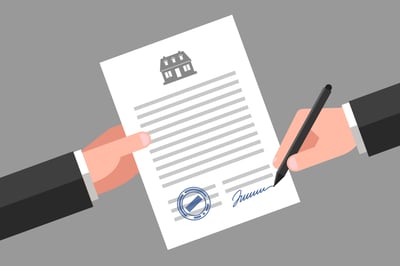July 11, 2023
 by Rachana Chotia / July 11, 2023
by Rachana Chotia / July 11, 2023

Contracts are the foundation for business success, impacting every facet of operations–from hiring top talent and building partnerships to selling products and leasing office space. They establish trust, protect interests, manage risks, and enable smooth operations within an organization.
But here’s the thing. Traditional contract management methods are chaotic. Dealing with manual processes, physical documents, and endless email back-and-forths slows everything down and opens the door to errors and missed opportunities.
Fortunately, there is a solution: contract workflows.
By embracing automation, centralizing contract repositories, and using electronic signatures, businesses can introduce order into their contract management processes and enhance overall efficiency.
This article explores contract workflows and ways to streamline them to capitalize on opportunities swiftly and effectively.
A contract workflow is the steps involved in a contract’s journey from creation to completion. It typically includes contract drafting, reviewing, approval routing, electronic signature, tracking, and storage.
Traditional contract management methods are often inefficient and substantially impact a company’s bottom line. Studies show that companies can lose as much as 9% of their profits due to ineffective contract management.
Some common challenges associated with traditional contract management include the following:
Manual processes are time consuming, often leading to delays in contract execution, resulting in increased turnaround times and missed opportunities. Navigating through piles of paperwork, creating contracts from scratch, managing versions, or tracking down approvals consume valuable time and drain resources that could be better employed elsewhere.
Without a centralized system, gaining insight into the status and progress of contracts at each stage becomes difficult. Tracking contract versions, amendments, and negotiations can be challenging, leading to potential errors and miscommunications. Businesses often struggle with scattered contract information, making it hard to keep everyone on the same page.
Relying on physical documents poses risks such as loss, damage, or unauthorized access. These risks jeopardize the confidentiality and integrity of sensitive contract information. Moreover, ensuring compliance with data privacy regulations (GDPR, CCPA), industry standards (HIPAA, ISO 27001), and legal requirements becomes increasingly challenging when dealing with physical documents.
Manual handoffs and physical document circulation in contract workflows lead to communication delays and inefficiencies. Coordinating contract reviews, edits, and approvals across departments and stakeholders is time consuming and error prone. It can result in missed deadlines and miscommunications.
Manual contract processes have several associated costs that can impact a company’s budget. Expenses such as printing, paper storage, postage, administrative tasks, and physical client interactions add up. Additionally, travel costs can be significant, including transportation and accommodation for in-person meetings and contract signings. The time spent traveling to meet clients and conducting face-to-face negotiations further adds to resource inefficiencies.
Need to draft a legally sound agreement? Check out our step-by-step guide on how to write a contract that protects all parties and holds up in court.
Streamlining contract workflows means automating and standardizing the steps involved in managing contracts. It involves using workflows to organize tasks and actions, ensuring the right people have the right documents at the right time. The goal is to simplify the process as efficiently and accurately as possible.
Here are six ways you can streamline contract workflows at your organization.
Source: Signeasy
E-signature solutions streamline contract workflows by eliminating the need for physical document handling, such as printing, signing, scanning, and mailing. Instead, contracts can be signed digitally, saving time and resources and reducing the risk of errors or loss.
E-signatures also enable remote collaboration and expedite the signing process. Parties can sign electronic contracts from anywhere, anytime, using their devices. It eliminates the need for in-person meetings or coordinating multiple schedules, speeding up contract execution and reducing delays.
Moreover, electronic signatures offer enhanced security and authenticity. Advanced encryption techniques and authentication mechanisms ensure the integrity and validity of the signed contracts. Digital audit trails record who signed the document and when, which adds an additional layer of security and accountability.
By streamlining the signing process, e-signatures improve overall efficiency and productivity. They reduce administrative burdens, eliminate paper-based inefficiencies, and provide a seamless experience for all parties involved.
Businesses can achieve several benefits by consolidating all contracts into a centralized system. First, it enables easy access, tracking, and retrieval of contracts. Users can quickly locate and retrieve contracts from a single source instead of sifting through physical files or searching across various systems. It saves time, reduces errors, and enhances efficiency in managing contracts.
Centralization facilitates real-time collaboration and updates. Multiple stakeholders can access and work on contracts simultaneously, eliminating the need for manual handoffs and reducing delays. With instant notifications and shared access, teams can collaborate seamlessly, make edits, add comments, and track changes in real time, leading to faster contract approvals and improved productivity.
Furthermore, a centralized system provides better visibility and control over the contract lifecycle. It allows businesses to track key milestones, monitor contract performance, and manage renewals or expirations more effectively. This proactive approach helps mitigate risks, ensure compliance, and optimize contract management processes.
With configurable workflows, you can design a seamless path for your contracts to follow. It reduces manual effort and saves valuable time. For example, document generation can be automated, creating standardized contract templates with dynamic fields that can be populated with relevant information.
Approval workflows can also be automated by defining the sequence of approvals and triggering notifications to the appropriate stakeholders. It expedites the review and approval stages, reducing delays and improving efficiency.
Automated notifications and alerts keep stakeholders informed about contract status, key milestones, approaching deadlines, and required actions. It improves communication, ensures timely responses, and reduces the risk of missed deadlines or overlooked tasks.
By connecting contract management software with other essential software systems, users can access all relevant information and perform necessary actions within a single interface, eliminating the need for manual data transfer or toggling between various applications. It saves time and effort, reduces the risk of errors, and enhances user experience.
Integrating with popular workspaces like Microsoft and Google, along with CRM, ERP, or HR software, enables users to sign, send for signature, and track contracts without leaving their workspace. This integration ensures that contract-related information is accurately shared across systems, eliminating the need for manual data entry.
Integration creates a unified environment where contract-related tasks seamlessly align with your broader business processes. For example, automation of contract creation based on opportunities. When a new opportunity is identified in the CRM system, relevant contract templates can be automatically generated, saving time and improving consistency.
A contract template is a pre-designed document that serves as a starting point for creating contracts, providing a structured format that can be customized to reflect specific details. Having a collection of standardized contract templates enables faster drafting. Instead of starting from scratch each time, users can easily access pre-approved templates tailored for specific purposes. It expedites the contract creation process, saving time and effort.
Maintaining a library of commonly used documents, contracts, and agreements ensures easy access to approved templates. It promotes consistency in contract language and structure, reducing the chances of errors and inconsistencies in contract creation.
Contract template libraries also help ensure document version control. By centralizing templates in a library, businesses can easily manage and update them as needed. It guarantees that users always work with the most recent versions, reducing the risk of using outdated templates and maintaining compliance.
Contract analytics software allows businesses to gain a deep understanding of contract performance. Organizations can identify patterns, trends, and areas of improvement by analyzing data related to contract status, turnaround times, and usage. This knowledge enables them to make data-driven decisions, optimize workflows, and address bottlenecks, ultimately streamlining the contract management process.
Generating reports on contract metrics provides a comprehensive view of contract activities and performance. These reports offer real-time visibility into contract status, milestones, and key performance indicators. With this information readily available, stakeholders can easily track progress, identify delays, and take proactive measures to keep contracts on track.
By analyzing historical contract data, businesses can proactively address issues, mitigate risks, and optimize workflows to improve overall contract management.
Contracts are integral to different teams, such as legal, sales, and finance. Collaboration and coordination among these teams facilitate interactions, reduce handoffs, and improve communication. It boosts productivity, reduces errors, speeds up contract cycles, and ultimately delivers better outcomes for the organization.
Let’s see how different teams streamline contract workflows.
Sales and marketing teams use contracts to support their activities, including sales agreements, marketing partnerships, service level agreements, and non-disclosure agreements. These teams work closely with legal professionals to ensure compliance and negotiate contract terms. And they collaborate with finance teams to manage pricing, payment terms, and revenue recognition.
Sales and marketing teams automate contract creation, approval processes, and document tracking. It expedites contract execution and eliminates manual paperwork. This collaborative approach enhances productivity, improves customer relationships, and drives revenue growth.
The legal department handles vendor agreements, client contracts, employment agreements, non-disclosure agreements, and licensing agreements. Collaboration is vital for the legal department as they work closely with various teams, including procurement, HR, finance, and executive leadership.
The legal department automates contract creation, approval processes, and document storage to streamline contract workflows. Centralizing contracts in a digital repository allows them to easily track contract status, access relevant documents, and collaborate with stakeholders in real time. It enhances contract visibility, reduces manual errors, and ensures compliance with legal requirements.
HR teams use employment contracts, offer letters, confidentiality agreements, and non-compete agreements in their workflows. Streamlining contract workflows in the HR department involves collaboration between HR professionals, legal teams, hiring managers, and new employees.
HR teams can expedite the contract management process by leveraging technology such as e-signatures and automated workflows. It includes drafting and sending contracts for review and approval, capturing electronic signatures, and securely storing and managing contract documents.
IT operations teams facilitate technology implementations, vendor engagements, service-level agreements, and maintenance contracts. These contracts are essential for managing relationships with external vendors, ensuring smooth operations, and maintaining the integrity of IT infrastructure.
Streamlining contract workflows in the IT operations departments involves collaboration among IT professionals, procurement teams, legal departments, and external vendors. By leveraging efficient contract management tools and processes, these teams can streamline contract creation, negotiation, and execution.
Finance and accounting teams use contracts to manage financial agreements, vendor relationships, client engagements, and compliance obligations. These contracts ensure accurate financial transactions, mitigating risks and maintaining financial integrity.
The finance and accounting departments collaborate with legal teams, procurement departments, and external parties. Automated contract workflows help track contract milestones, payment terms, and financial obligations, ensuring timely invoicing, payment collections, and compliance with contractual terms.
By streamlining contract workflows, finance and accounting teams can enhance financial accuracy, improve cash flow management, mitigate contractual risks, and ensure regulatory compliance.
In various industries, streamlining contract workflows brings specific advantages tailored to the needs of each sector. Let’s look at them below.
Hospitals, pharmaceutical companies, research institutions, and healthcare providers rely on efficient contract management for smooth functioning and compliance. It involves managing agreements with vendors, suppliers, healthcare providers, and insurers.
One key aspect is ensuring compliance with regulatory requirements and privacy laws, such as HIPAA, to safeguard sensitive patient information.
Efficient contract workflows enable timely contract execution, enhance stakeholder collaboration, and help meet contractual obligations. By leveraging digital tools and automation, healthcare organizations streamline their contract processes, focusing on patient care and fostering positive stakeholder relationships.
Technology companies, software vendors, and SaaS providers rely on streamlined contract management to drive innovation, maintain customer relationships, and comply with industry regulations.
Contract workflows in the technology sector encompass a range of agreements, such as software licensing agreements, service-level agreements, software development contracts, intellectual property agreements, and partnership contracts. These contracts define the rights, obligations, and expectations of both the technology provider and the client.
Moreover, technology companies operate in a highly regulated environment. They need to comply with data privacy regulations, security standards, and industry-specific regulations. Streamlining contract workflows enables organizations to ensure compliance, manage risk, and demonstrate adherence to legal requirements.
In the real estate industry, contract workflows are crucial in managing lease agreements, property sales contracts, and vendor contracts. By streamlining these workflows, real estate professionals can automate processes like rental agreements, lease renewals, and property maintenance contracts, saving time and effort.
Effective contract workflows also improve communication and collaboration between property owners, tenants, and property management teams, ensuring a smooth and efficient operation. Moreover, streamlining contract workflows helps real estate organizations comply with local regulations and legal requirements, minimizing the risk of errors and ensuring a legally sound process.
In the manufacturing industry, streamlined contract workflows ensure smooth operations, from managing supplier contracts and procurement agreements to handling supply chain contracts.
Manufacturers can save time and resources by automating purchase orders, supplier onboarding, and contract renewals, allowing them to focus on core business activities. Additionally, efficient contract workflows enhance collaboration between manufacturers, suppliers, and distributors, fostering more robust partnerships and seamless communication throughout the supply chain.
Contract workflows in the financial services industry automate loan agreements, client onboarding, and compliance documentation. It enables faster processing, reduces manual errors, and improves customer experience.
Organizations can ensure transparency, reduce delays, and strengthen client relationships by facilitating collaboration between financial institutions, clients, and legal teams. Streamlined contract workflows ensure financial services adhere to regulations, such as anti-money laundering (AML) laws and Know Your Customer (KYC) requirements.
By streamlining contract workflows, institutions can implement robust compliance measures, monitor regulatory changes, and mitigate compliance risks.
With the abundance of options available, finding the software that best suits your organization’s needs can be challenging.
To help you make an informed decision, here are five essential questions to consider when selecting an e-signature and contract workflow software.
Ease of use is a critical factor in choosing e-signature software. Look for a solution that provides an intuitive interface, allowing employees to sign documents easily and quickly. Features such as sending contracts to multiple signers simultaneously, signing multiple documents in one session, creating reusable templates, triggering additional workflows, and real-time status updates are essential for a streamlined and convenient signing experience.
Consider the compatibility of the software with your current business applications. Look for e-signature solutions seamlessly integrating with popular tools. The software should have prebuilt connectors or flexible APIs to ensure smooth data exchange and streamline your workflow across different platforms.
In today’s mobile-centric world, choosing software that provides a seamless experience on mobile devices is crucial. Look for e-signature solutions that offer native apps for major platforms such as iOS, Android, and the web. It allows employees to securely send, sign, and manage documents on the go, improving productivity and ensuring the timely completion of tasks.
Security is a top concern when it comes to handling sensitive documents. Ensure the e-signature software provides robust security measures like SSL encryption for document protection. Look for features like authentication methods (log-in credentials, secure digital signatures), compliance with industry standards (e.g., E-SIGN Modernization Act, eIDAS, HIPAA, SOC 2), and a detailed audit trail to track the signing process and provide legal evidence if needed.
Consider the scalability and cost effectiveness of the software. If your organization is in high growth, choose a solution that can accommodate your expanding needs without incurring significant additional costs. Look for fast implementation, enjoyable user experience, reliable customer support, and cost-saving features that can replace paper-based signing processes.
Smaller organizations with limited budgets should seek vendors that offer easy-to-manage solutions, seamless integration with existing applications, and scalability for future use cases. Always choose a vendor that provides comprehensive implementation, training, and change management support to ensure a successful transition.
The transition from chaos to order in contract management workflows is not just a possibility but a necessity for businesses to succeed. Organizations can streamline their contract workflow practices with the power of automation and a digital-first mindset.
By embarking on this path, businesses open doors to optimized processes, reduced risks, and high performance. This transformation unlocks enhanced efficiency, cost reduction, and a culture of collaboration.
Searching for the best tool for your business is vital as the secret to contract management lies in the software.
Rachana is a Content Marketing Manager at Signeasy, the leading electronic signature and contract workflow software. In addition to her expertise in writing about SaaS software and its ability to address customer issues, Rachana loves taking long walks and traveling.
Every dollar in and out of a company is tied to a contract.
 by Kshitija Agrawal
by Kshitija Agrawal
In the world of sales technology, CRM, sales intelligence, proposal generation, and sales...
 by Gideon Thomas
by Gideon Thomas
As artificial intelligence (AI) becomes the norm in legal operations, more and more legal...
 by Simon McCarthy
by Simon McCarthy
Every dollar in and out of a company is tied to a contract.
 by Kshitija Agrawal
by Kshitija Agrawal
As artificial intelligence (AI) becomes the norm in legal operations, more and more legal...
 by Simon McCarthy
by Simon McCarthy


